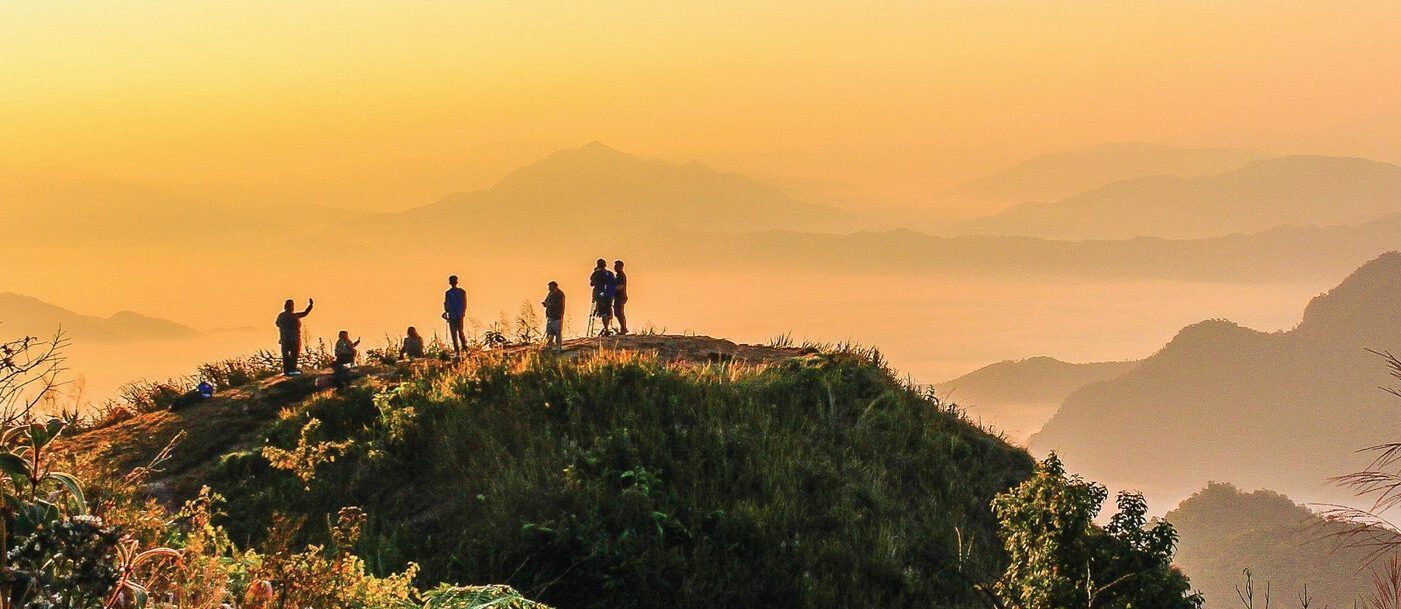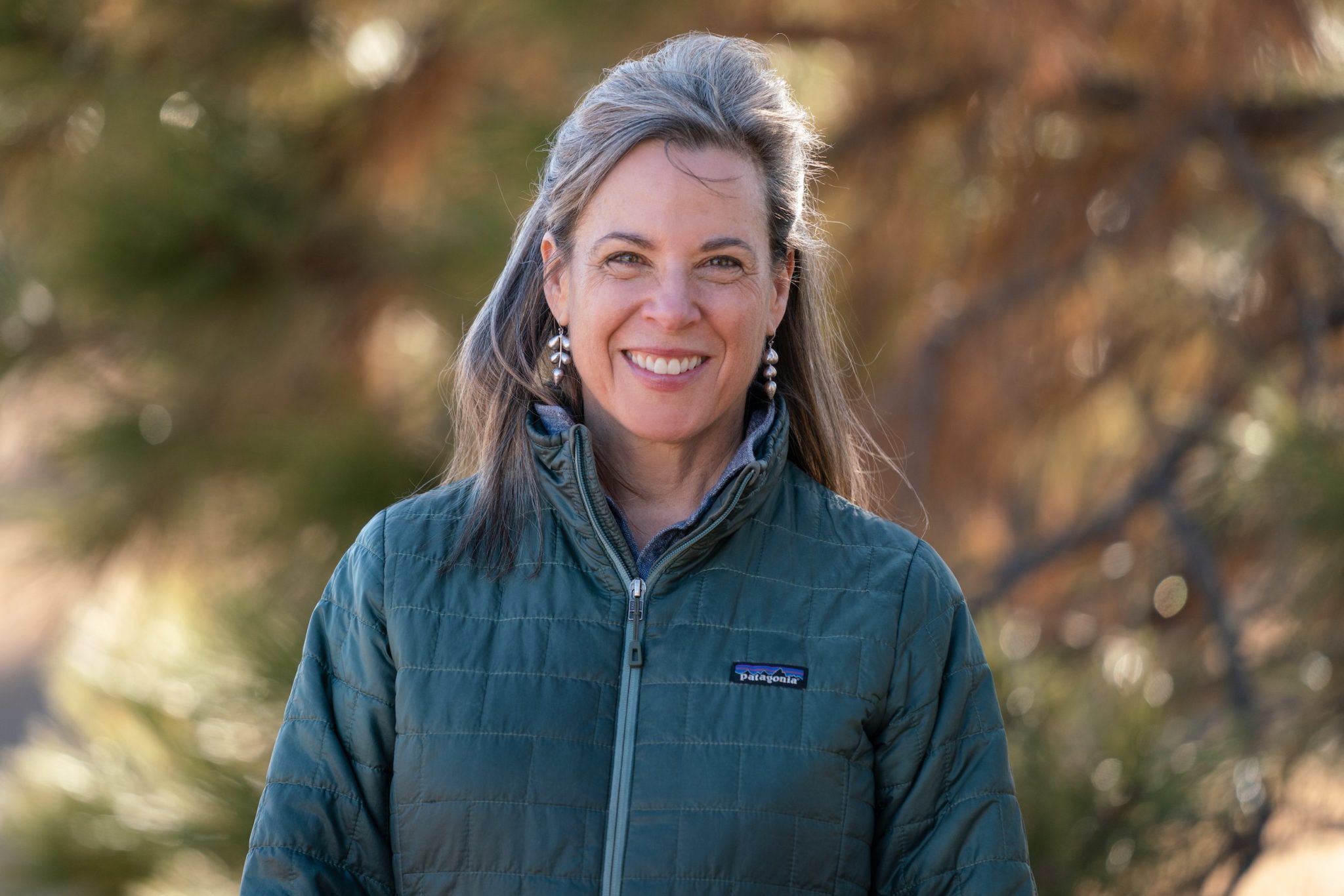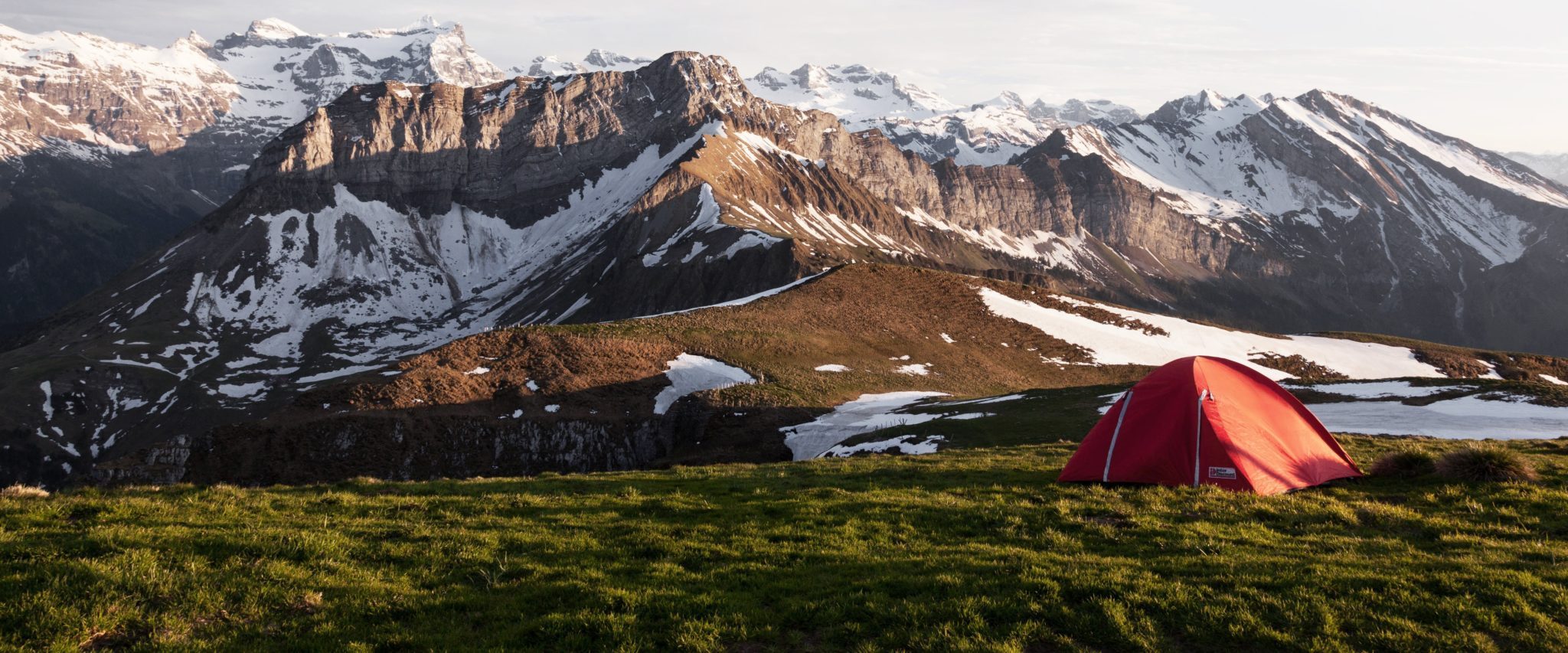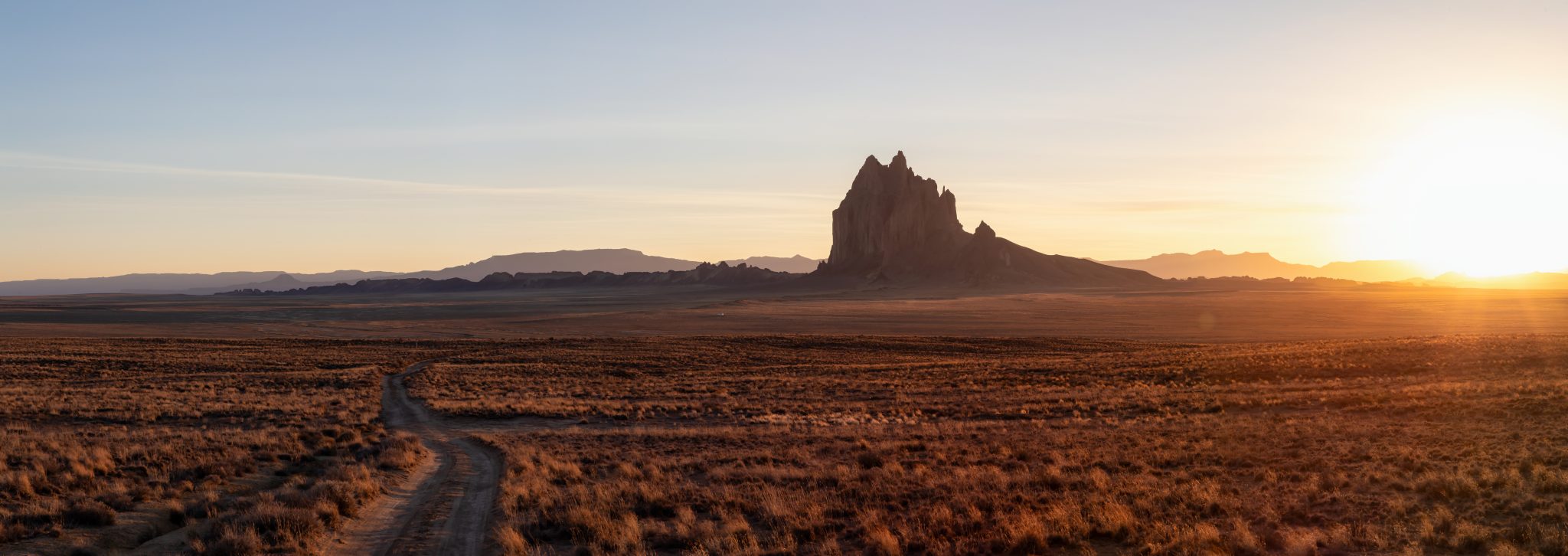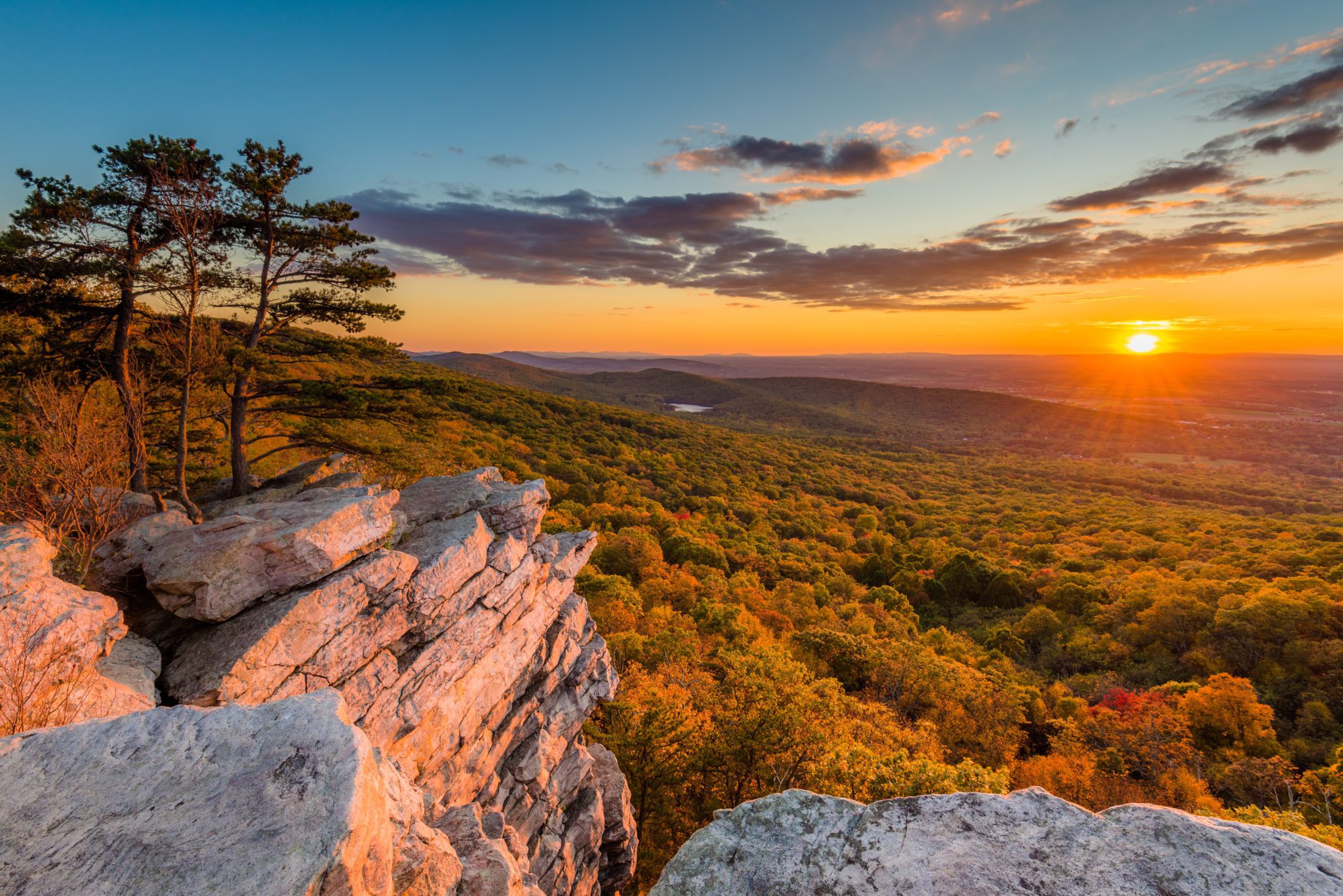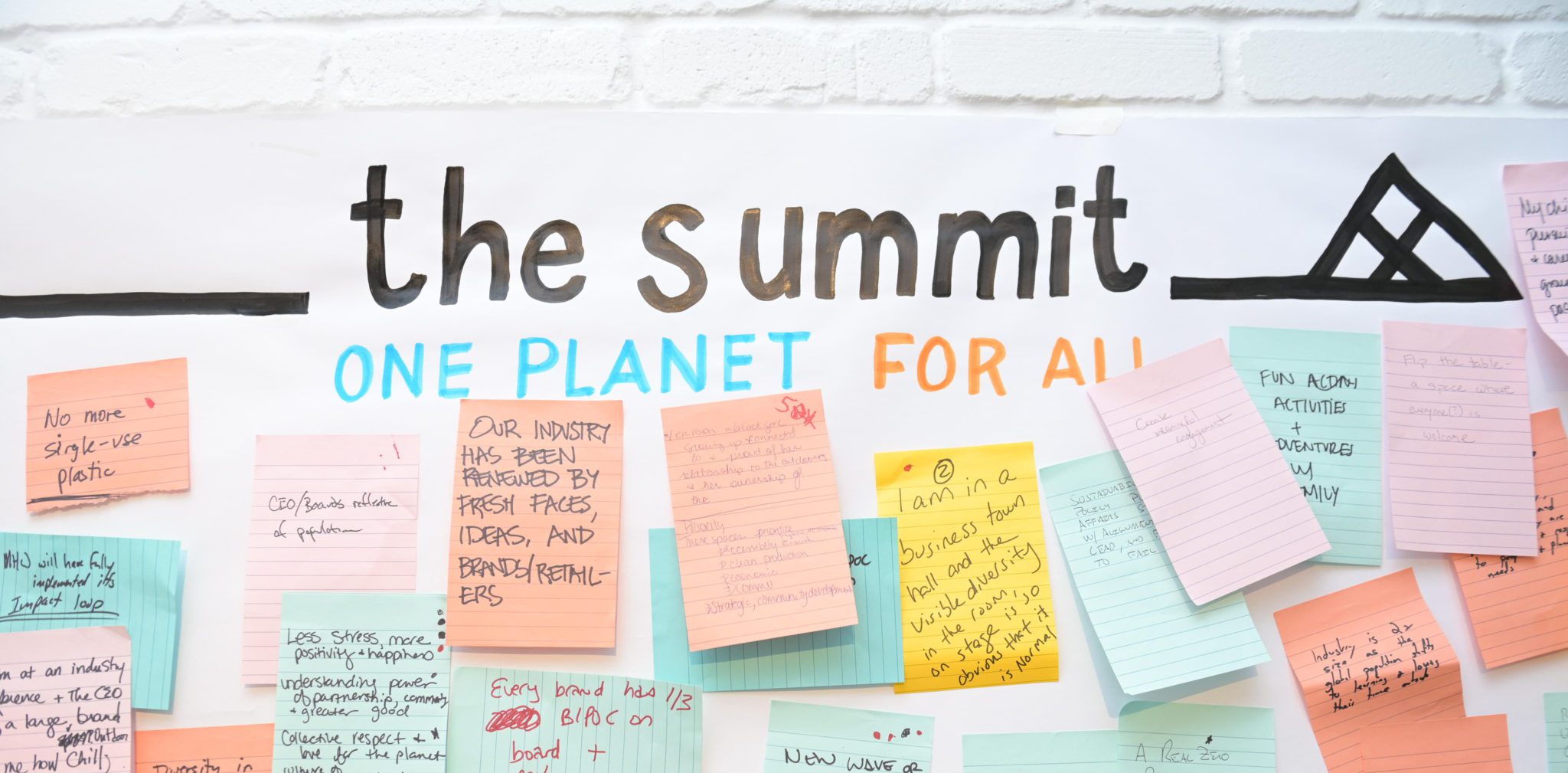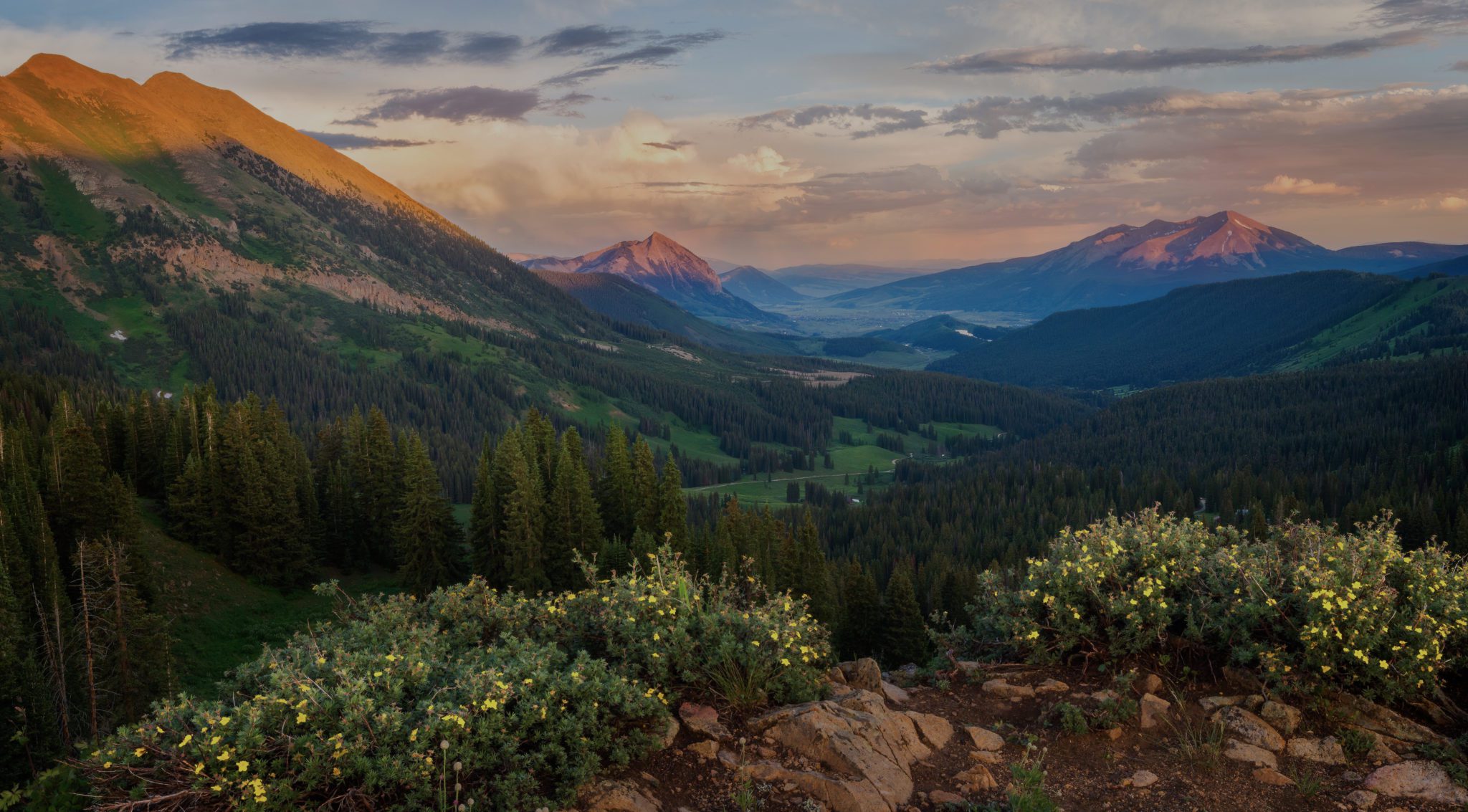We’re happy to announce two returning board members and two new incoming members, who will take their seats officially at the upcoming board meeting in September.
Continue readingLetter to the Industry from Lise Aangeenbrug, OIA Executive Director
Dear OIA members,
With deep appreciation and mixed emotions, I am writing to you today to share that I will be resigning as executive director of Outdoor Industry Association as of August 19, 2022.Despite the many challenges we have seen as an industry and nation over the last two and a half years, the outdoor industry remains strong, and our members remain engaged. The outdoor industry’s trade association is traveling in the best direction possible, which gives me confidence as I leave OIA to take some time to recharge outside and then join the National Park Foundation. Protecting and restoring public lands and waters and ensuring an outdoors for all has always been a major focus and motivation in my career.I am grateful for the opportunity I have had to serve the outdoor industry and be a part of the accomplishments that the OIA team achieved for our members over the past several years. Like our industry, we had to pivot as the pandemic upended our business and personal lives, but we came out stronger for it.Together, we bolstered OIA’s state and federal advocacy for the outdoors; championed trade and tariff policies that benefit the outdoor industry; represented the outdoor industry at the White House; built partnerships such as the Outdoor Industry Business Certificate programs with universities; enhanced our research capabilities; created and implemented a new community grant program for the Outdoor Foundation; launched and championed the Climate Action Corps; created The Summit, a new industry thought leadership event; and built a new business model that reflects OIA member priorities. Under the leadership of the OIA Board of Directors and COO Dr. Arlene Charles and powered by a dedicated and talented staff, OIA is poised to continue to deliver member value and bring the outdoor industry together around collective action for business, people, and the planet.It truly has been an amazing two and a half years at OIA and two years prior to that with OIA’s charitable arm, the Outdoor Foundation, working with a range of industry companies, from mom-and-pop shops to large iconic brands. As I transition into a more philanthropic role in partnership with many in the outdoor industry, I would like to thank you all for the opportunity you have given me to serve our industry and lead its work.The OIA Board is actively searching for an interim executive director with strong industry and management experience, and the search for a permanent executive director will begin shortly. We will share more information about that process with the industry in the coming weeks.Please do not hesitate to reach out to me; Arlene Charles, COO; or Phyllis Grove, OIA Board chair, if you have concerns or questions.Sincerely, 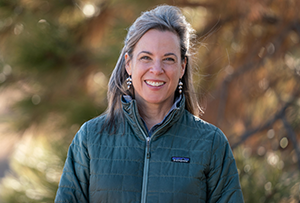
Lise Aangeenbrug Executive Director Outdoor Industry AssociationAbout the Outdoor Industry Association
Based in Boulder, Colo., with offices in Washington, D.C., Outdoor Industry Association (OIA) is the leading trade association for the outdoor industry. For more than 30 years, OIA has served as the trusted convenor, resource, and voice of the outdoor industry. OIA unites and serves manufacturers, suppliers, sales representatives, and retailer members through its focus on trade and recreation policy, sustainable business innovation, and outdoor participation. The association provides its members with insights, advocacy, and opportunities for action that support the long-term success of outdoor businesses and ensure the outdoor experience for all. For more information, visit outdoorindustry.org
Research Roundup: July 2022
Here at OIA, our research team focuses on providing you with insights into the outdoor consumer: what drives their choices, what gear they choose, and what they value about their outdoor experiences. With our new monthly newsletter — Research Roundup — we aim to deliver the best data from our partner, CivicScience, who can reach hundreds of thousands of consumers in real-time to ask questions and gather insights that give you clear insights. You’ll also gain easy access to the full catalog of research reports we offer as well as trends we are tracking.
Happy reading!

Kelly Davis
Director of Research
Outdoor Consumer Intelligence: One in Three Hikers Identify as Fashionistas; the Other Two Want Comfort, Function, and Value
This week, we look at the fashion sense of hikers. Nearly 60 million Americans will hike in 2022, so we wondered how they think about fashion trends and their hiking apparel. We worked our way through CivicScience’s consumer intelligence database and found some clues. Turns out, most hikers (68 percent) say they don’t care about fashion trends at all, and interest in fashion declines with age. Men are far less likely to say that fashion trends influence their hiking apparel choices, and young women are most likely to self-identify as fashion innovators, leaders, and followers.
These insights could help suppliers and retailers better understand their customers and more effectively target different segments. Check out the data:
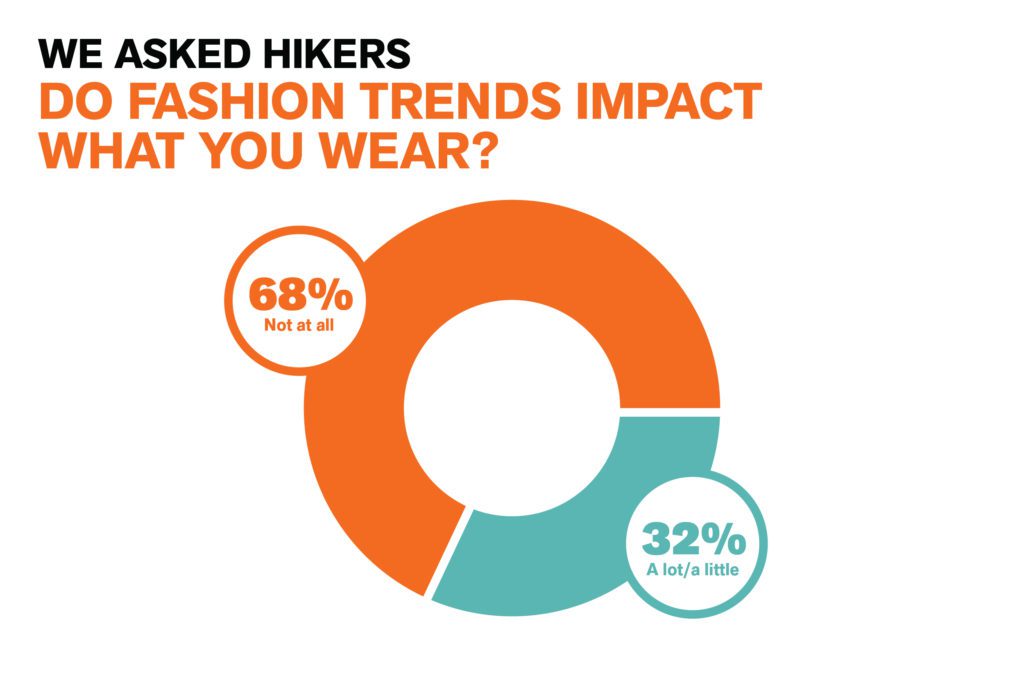 Nearly all (93 percent) of the hikers who say “trends do not impact what I wear” report that they are just “not into fashion.” These consumers are more likely to consider functionality, durability, value, and comfort over style or trendiness when deciding what to buy.
Nearly all (93 percent) of the hikers who say “trends do not impact what I wear” report that they are just “not into fashion.” These consumers are more likely to consider functionality, durability, value, and comfort over style or trendiness when deciding what to buy.

The segment that reported that trends don’t impact their choices AND indicated that “they are not into fashion” is made up of mostly male (68 percent) and older hikers, including men over 55 (88 percent) and women over 55 (72 percent).
Among the 32 percent of hikers (see figure 1) who say that fashion trends do impact what they wear are self-professed fashionistas: 26 percent of them consider themselves either fashion innovators or leaders, and 28 percent say they are fashion trend followers. And about half of those who say trends do impact what they wear say they are not into fashion; this seems confusing, but humans can be complex—some individuals realize that, even though they are not focused on fashion, trends still have an impact on what they wear on the trail.
This group will consider look, trendiness, and brand appeal to varying degrees when they purchase outdoor apparel. This group would also be more likely to prioritize buying a fresh look before considering product features like functionality, durability, value, and comfort. Females make up 60 percent of this group, and males make up 40 percent.
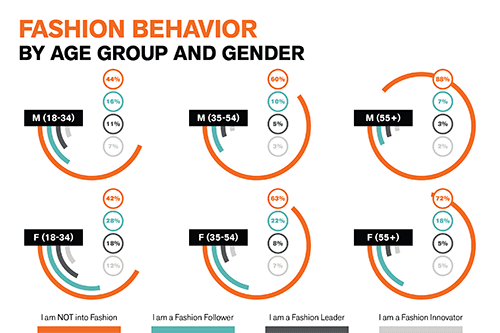
Regardless of gender, older consumers are less likely to be influenced by fashion trends, and older males are most likely not to be into fashion or trends. Young females, however, are most interested in fashion trends. In fact, 30 percent of women ages 18 to 34 consider themselves fashion innovators or leaders, and another 28 percent of women in this age group said they are fashion followers.
Selling into this market will require brands to be focused on trend with their products as opposed to being focused on value, durability, functionality, and comfort. That doesn’t mean that products that are trendy will not also need the more solid features like functionality and durability, but young consumers will make their calculations differently when purchasing apparel and will be more likely to choose style over substance.
 Trend Spotter: Meet the Coastal Grandmother
Trend Spotter: Meet the Coastal Grandmother
A growing group of women of all ages are dressing like they spend their days on art, philanthropy, and wine-fueled mischief at their beach houses. The look is simple, clean, neutral, and comfortable. Learn more about the trend here.
Data Trail Mix: Outdoor Participant Base Continues to Grow Post Pandemic Surge
Outdoor recreation is a large and growing industry that produced $689 billion in economic output in 2020, supports 4.3 million jobs, and is enjoyed by 165 million Americans over the age of 6 or roughly 53 percent of the total U.S. population. The outdoor industry has always been large, but the COVID-19 pandemic drove growth across the industry: More than 10 million new participants have enjoyed outdoor recreation since March 2020. Limited options for safe indoor activities during the pandemic—particularly group activities—drove growth in outdoor recreation, especially prior to the delivery of vaccines. However, the continued growth of the participant base in 2021 indicates that the need for safer places to interact was not the sole variable driving growth.
Categories that attracted many new participants during the pandemic—including walking, hiking, car camping, trail running, skateboarding, and birdwatching—are some of the most accessible activities, and they enjoyed continued growth in 2021 following their epic increases in 2020.
State and Local Policy Dispatch: Q3 2022
Welcome to the State & Local Dispatch, a quarterly newsletter with key state-level updates that impact our industry and communities.
Continue readingThe Great Maryland Outdoors Act: A win for MD’s outdoors, community, and economy

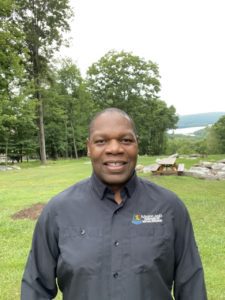
As 2022 state legislative sessions wrap up and we reflect on major policy wins across the U.S., The Great Maryland Outdoors Act is a clear standout. OIA staff connected with Daryl Anthony, executive director of the Maryland Office of Outdoor Recreation, and western region manager Christy Bright at the Maryland Park Service, to learn more about the positive impacts this bill will have on Maryland’s outdoors, its citizens, and the state’s outdoor economy.
Like many other states, Maryland’s park system saw a marked increase in traffic across its 77 units throughout the pandemic. Much of the increase in visitation was experienced in regions most accessible to nearby major metropolitan areas and in neighboring states. Alongside increased traffic came escalated stress on the resources of the Maryland Park Service. Equity and access concerns for underserved communities also became a greater priority. These conditions sparked discussion on how to address these new challenges. The result? The Great Maryland Outdoors Act.
This act is an instructional example of collaboration between bipartisan lawmakers, state institutions, and other stakeholders working together to understand the needs of the Maryland Park Service, the Department of Natural Resources (DNR), and their employees. According to Executive Director Anthony, the Great Maryland Outdoors Act is “geared toward advancing operations and capability of the Maryland Park Service.” These targeted investments will address specific resource shortages and will enhance the capacity of the DNR and its departments.
Here are some of the components of the act:
- The act increases the number of permanent employees in the Department of Natural Resources, which will add institutional capacity to address challenges affiliated with increased visitation, safety, and aging infrastructure.
- The state’s Critical Maintenance Fund will receive an additional $70 million to address state park maintenance needs. These funds and the work they enable should positively impact the outdoor recreation industry across the state by updating infrastructure in and around recreation amenities.
- The Park System Capital Improvement and Acquisition Fund established in the act will allow the state to acquire additional land for state parks. Further development of outdoor amenities will alleviate overcrowding and access issues. Part of the funding allotted in the fund must also go toward climate change mitigation infrastructure projects.
- The act also establishes a Parks and Recreation Commission, which will oversee the Maryland Park Service. The commission will have representation from the legislature, appointees from the executive branch, Maryland citizens, and members specifically focused on environmental justice and sustainable communities.
- The creation of the $3 million Great Maryland Outdoors Fund directly applies to Maryland’s Office of Outdoor Recreation. The fund will be used to implement recommendations from the Maryland Outdoor Recreation Economic Commission. The monies may also be applied toward department projects and programs that “provide, promote, and enhance outdoor recreation opportunities in the State.” Some funding is also allotted to the marketing and promotion of state parks.
- Finally, the Great Maryland Outdoors Act establishes that the DNR work with the state’s Department of Labor to identify opportunities to create registered apprenticeship programs “to help address workforce shortages and the career workforce needs of DNR.”
These sizable investments will result in a triple-bottom-line return for the state by imparting direct positive impacts on the health and wellness of the state’s citizens and the health of the environment, and they will enable further development of an outdoor recreation economy that already provides Maryland $5.5 billion in value-added to the state’s economy annually while supplying approximately 69,337 jobs for residents. Executive Director Anthony noted that the act reflected a host of favorable conditions developing in the right place at the right time, including a partnership with the state’s executive branch. “Governor Hogan recognizes the value of outdoor recreation and the need to have this opportunity available for the citizens of Maryland for their overall quality of life,” said Anthony.
After this significant policy victory, what’s next? Both Executive Director Anthony and Western Region Manager Bright say there are other needs and opportunities they will be focused on: growing public and private investment in green technologies to improve access, updating recreation amenities like campgrounds, and further improving the user experience. Finally, Bright points out that the vitality of the outdoor economy and Marylanders themselves rely on the health of the natural assets across the state. Traditional conservation efforts are still front-of-mind for the DNR, including a continued focus on the protection of the Chesapeake Bay.
We at OIA are big fans of the Great Maryland Outdoors Act. State parks across the country are chronically underfunded even while seeing notable traffic increases. Our industry can utilize our collective voice to address this issue over the coming years.
Ready to learn how you can advocate on behalf of increased investment in parks, green infrastructure, and recreation amenities? Contact Rebecca Gillis, OIA’s State and Local Government Affairs Manager, to learn more about the tools OIA offers to our members to step up and call on elected officials to strengthen the outdoors and outdoor economy.
The Summit: What Happened and What’s Next
Read highlights from The Summit, our industry’s next steps, and how you can get engaged. Take a look at photos from the event and a thank you to our sponsors here.
In service of OIA’s mission to support the long-term success of outdoor businesses and ensure the outdoor experience for all, we hosted The Summit last month, a first-of-its-kind event bringing together 100+ leaders across the outdoor ecosystem to collaborate and commit to act on the most pressing issues – and greatest opportunities – of our time: climate change and outdoor equity.
Our intention for The Summit was for business executives, community-based partners, and policymakers to come together and make bold commitments toward a shared future that is inclusive, equitable, and climate positive. We knew that in order to be successful, this event required a different approach and design than industry convenings in the past, and we engaged community leaders and businesses across the outdoor ecosystem to co-create The Summit. It took over a year of planning, learning, and growing along the way.

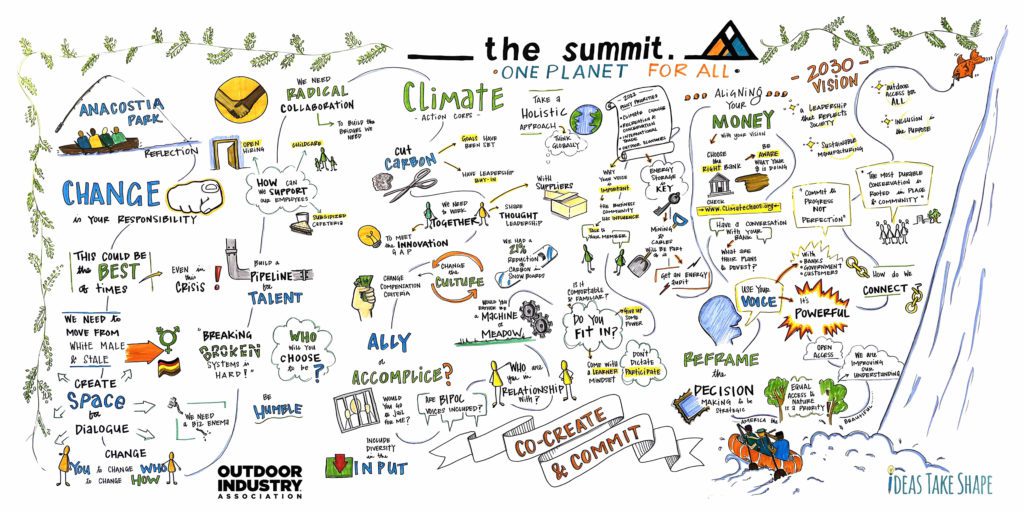
While The Summit is just the beginning, we are proud to see the progress our industry made through engaging in authentic conversations, challenging what we think we know, stepping into discomfort, and agreeing to collective action. Read on for highlights, our next steps, and how you can get engaged.
Together at The Summit, outdoor leaders:
1. Learned about the links between climate, equity, and inclusion and why they are vital to securing our shared future.
- Historian and award-winning journalist Jelani Cobb set the stage for engaging conversations on the dynamics of race in our society, relating the country’s history of inequality to today’s issues, including climate change.
 “The only way in which we have ever made social progress is by beginning to recognize our own fallibility, our own complicity and then proactively saying: it is incumbent upon us to do something different … the willingness to step aside from our comfortable position and ask ourselves how we factor, how we benefit, how we replicate the kinds of pre-existing conditions that we see routing disaster through that societal rain gutter to the most vulnerable parts of our population.”
“The only way in which we have ever made social progress is by beginning to recognize our own fallibility, our own complicity and then proactively saying: it is incumbent upon us to do something different … the willingness to step aside from our comfortable position and ask ourselves how we factor, how we benefit, how we replicate the kinds of pre-existing conditions that we see routing disaster through that societal rain gutter to the most vulnerable parts of our population.”
- Dr. Cobb joined our opening panelists Dr. Carolyn Finney, Middlebury College and Chris Speyer, REI to bring this historical context into a discussion about the present-day ethical and business drivers for bold, urgent action on climate, equity and inclusion. We learned that while diversity is accelerating in America, only 28% of the outdoor participant base is BIPOC (black, indigenous, and people of color) – off pace with the general population and that 3 in 4 BIPOC persons live in nature-deprived places, compared with 1 in 5 white persons. We explored our role as business and organizational leaders in both creating, perpetuating, and solving for these disparities.
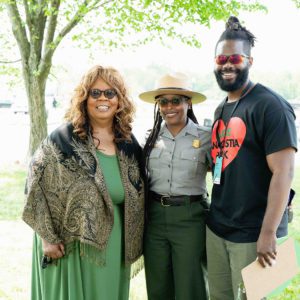
2. Amplified the leadership power already evident in outdoor community-based organizations and demonstrated what it looks like to meaningfully engage in sustained, healthy partnerships.
- At Anacostia Park, Thrive Outside D.C. community leaders and program participants led Summit attendees through a series of outdoor activities that highlight how the local community utilizes the park for healing, community, and growth.
- During the Ally to Accomplice session, panelists shared struggles and successes in our journey to overcome equity barriers to the outdoors, along with real-life partnerships that put trust in community leaders and build relationships that go beyond financial transactions.
3. Empowered and equipped each other to expand audiences, connect with customers beyond the transaction, and demonstrate our industry’s values and capacity for doing good.
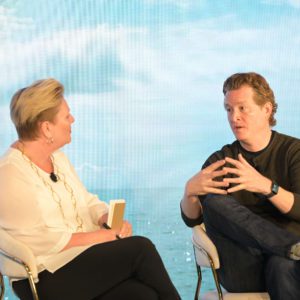
- Halla Tomasdottir, CEO + Chief Change Catalyst of The B Team, and Ryan Gellert, CEO of Patagonia, shared how successful stewardship of our businesses can exist alongside responsible stewardship of our communities and planet, along with practical guidance on how to implement a leadership model that places humanity at its heart.
- Climate change is not just a math problem: It’s a social justice issue and a threat to the outdoor experience for all. To break the cycle of injustice, bold action is needed across all sectors. Climate leaders and experts from YETI, Burton, and LifeStraw shared the ups and downs of setting science-based greenhouse gas reduction targets and meeting them. And a panel of climate finance experts illuminated how our banking decisions can support or undermine all that effort.
- Senator Angus King, I-ME, and Shannon A. Estenoz, Assistant Secretary For Fish And Wildlife And Parks, shared how businesses can help the administration take proactive and ambitious steps to preserve our public lands, combat climate change, make investments in green infrastructure, promote environmental justice, and ensure that the outdoors are open and accessible to all.
4. Built our leadership capacity for candor by listening and engaging in difficult conversations about equality and climate change.
- Dr. Gerilyn Davis, Founder and Chief Inclusion Officer of Inclusion on the Slopes, and OIA Board members shared real-life examples and tactics to help business leaders model inclusive behaviors, foster psychological safety, and build a fearless outdoor ecosystem.

5. Co-created and committed to act on a shared 2030 vision for an inclusive, equitable, and climate-positive future.
- Our force for change is a compelling vision that clarifies what our most passionately held desire for the future is. We were blown away to see the hundreds of visionary ideas generated by participants that collectively represent what this community most wants to see become a reality by 2030 on climate, equity, and inclusion – and what you’ll do to make it happen!
- See our 2030 vision + outcomes framework and meeting report-outs, and details below on how to contribute.
OIA is committed to the following immediate next steps to support our members and partners:
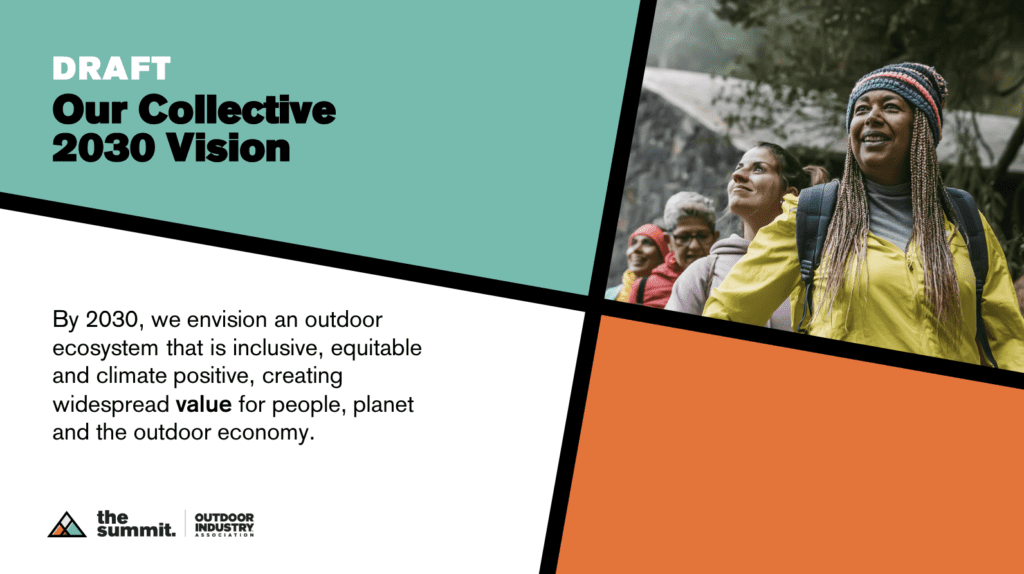 Finalize the 2030 vision.
Finalize the 2030 vision. 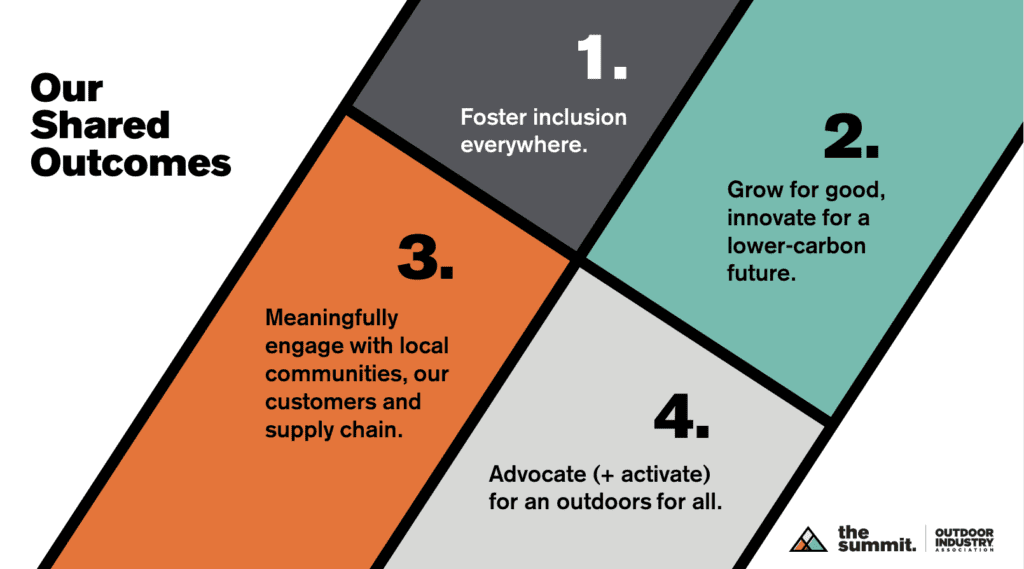 With your feedback and in consultation with partners and members, we will draft the next version of our shared 2030 vision and desired outcomes and share it back with the outdoor community this summer. This will serve as our collective North Star. The OIA staff and Board will use this to inform our strategy – including new programs and partnerships to advance climate and inclusion action. See below for how to contribute!
With your feedback and in consultation with partners and members, we will draft the next version of our shared 2030 vision and desired outcomes and share it back with the outdoor community this summer. This will serve as our collective North Star. The OIA staff and Board will use this to inform our strategy – including new programs and partnerships to advance climate and inclusion action. See below for how to contribute!
- Be a resource for action on equity and inclusion. While we already operate a thriving climate program called the Climate Action Corps, we want to do more to support our members to take immediate and holistic action on equity and inclusion – across product design and development, marketing, supply chain, and outdoor participation. OIA will conduct a deeper assessment of member needs, existing programs, potential partners, and gaps in this space to determine how we can play a unique and valuable role. We do not intend to reinvent the wheel; many great resources are already available, and we intend to align with and support existing programs wherever possible.
- Continue to advocate for inclusive and equitable climate policy, especially at this pivotal time as Congress weighs significant and consequential climate legislation. We will also continue our advocacy for federal, state, and local policies that help ensure an outdoors for all.
- Set the date and location for our next Summit in the Spring of 2023, as well as a separate D.C.-based fly-in to bring back our traditional annual lobbying event.
- Cultivate community on these business imperatives and beyond. In the meantime, OIA will explore the creation of cohort-based “meet-ups” that enable smaller groups of executives and teams to connect more frequently on common challenges and solutions that are critical for business success.
Here’s how you can continue to learn and act between now and our next opportunity to gather:
- If you did not attend the meeting, or just have more to say, contribute to our 2030 vision + outcomes by clicking here and following the prompts to add your ideas and let us know what you need to take action.
- Action on climate and equity is easier when you can collaborate with your peers. Join the OIA Climate Action Corps and sign the In Solidarity Outdoor CEO Diversity Pledge if you have not already – then, take a stand and make your commitment public! If you have already done both, how can you take your commitment to the next level?
- Sign on to this timely climate policy letter by June 9, urging Congressional action on bold emissions-reducing legislation. It may be our last significant moment for the scale of climate policy action needed to help all companies and the U.S. achieve our climate targets.
- Money doesn’t just sit in a bank – it goes out in the world and finances things. Find out whether your company’s money is helping fund a sustainable future or fueling the climate crisis, and learn how you can take action.
- Join this list to stay informed on OIA’s work in these spaces.
- Stop by this Outdoor Retailer session on Thursday, June 9 at 3:30 MT to get a deeper look into what happened at The Summit and what’s next.
OIA is the trusted convenor, resource, and voice of the outdoor industry in the U.S. We collaborate to support the long-term success of outdoor businesses and ensure the outdoor experience for all. When you become a member of OIA, you gain access to the insights, action, and advocacy opportunities to help your organization and the greater outdoor ecosystem thrive.
Did you attend The Summit and are interested in connecting with speakers? Contact us.
For media inquiries, please contact Quinn Trainor at quinn@dennyink.com.
Advocating on Earth Day: State and Local Policy Updates
On this Earth Day, we on the OIA Government Affairs team are reflecting on notable state-level policies, regulatory changes, and investments that are accelerating important progress on climate, conservation, education, and outdoor access. To celebrate, we want to share some of these significant highlights with you in hopes that it inspires our members and fellow outdoorists to continue advocating for impactful policy on our planet’s behalf.
MICHIGAN
In late March of 2022, Michigan Governor Gretchen Whitmer celebrated the Building Michigan Together Plan. The $5 billion bipartisan plan is a blueprint for major investments to improve and modernize the state’s infrastructure.
The plan will have major implications throughout the state. We were excited to see that the governor outlined a planned $450 million investment in state parks. Of the total, $250 million will be allocated to state parks, including the development of a new state park in Flint, MI. An additional $200 million will go toward improving and developing local park systems throughout the state. Governor Whitmer’s administration noted that these investments will benefit the state’s outdoor recreation industry and will attract increased tourism to Michigan. Click here to learn more about these important investments.
CALIFORNIA
Late last year, California Governor Gavin Newsom’s administration made some exciting announcements to kick off 2022. Alongside California Secretary for Natural Resources Wade Crowfoot, the governor outlined $548.3 million in state grant funding to develop new parks in more than 100 communities throughout California. The press conference was part of a kick-off for the California “Outdoors for All” initiative, which will be led by Katherine Toy, the new and first-ever Deputy Secretary for Access at CNRA. US Secretary of the Department of the Interior, Deb Haaland, joined attendees for the launch of the initiative.
Learn more about the California Outdoors for All initiative and the catalytic investments here.
MARYLAND
In March 2022, the Maryland General Assembly passed the Great Maryland Outdoors Act (MD SB541). The bill was written partially in response to increasing visitor use seen throughout the pandemic, as well as growing need for resources to address deferred maintenance throughout the state. The legislation will provide increased funding for the state’s park system, the creation of new parks, and better access to existing parks.
The Great Maryland Outdoors Act will play a major role in, “addressing infrastructure, capacity, and accessibility needs within the Maryland Park Service and State parks,” and “increasing the number of Maryland Park Service full-time employees,” and finally, requiring the state’s Department of Natural Resources to make considerations “relating to the accessibility, inclusivity, safety, and location of State parks.” The law also establishes the Great Maryland Outdoors Fund to provide funding related to outdoor recreation in the state.
Read the final version of the bipartisan bill here.
WASHINGTON
Washington recently saw the creation of a statewide outdoor school program via a bipartisan bill, Establishing the outdoor school for all program (WA HB 2078). Ten million dollars in funding allocated from the state’s general fund will be used to administer an outdoor learning grant program supporting outdoor educational experiences throughout the state’s public schools. Washington youth in the fifth and sixth grades will be able to attend outdoor school starting as soon as the 2022-2023 academic year.
The program will be administered by the state’s Office of the Superintendent of Public Instruction. The office will allocate grants to eligible school districts and outdoor school providers, and will also partner with other relevant state agencies to carry out implementation.
Governor Jay Inslee said, “This is an important opportunity for our kids to experience quality instructional time outdoors, and it may even inspire them to pursue exciting careers in earth science and land management, which will help prepare our state for the challenges of climate change.”
Interested in learning more about our government affairs work on the state and local level? Read more here.
Collective Impact, Outdoor Equity, and Thrive Outside: Our Model Unpacked
Collective impact brings people together—in a structured way—to achieve social change.
Continue reading



